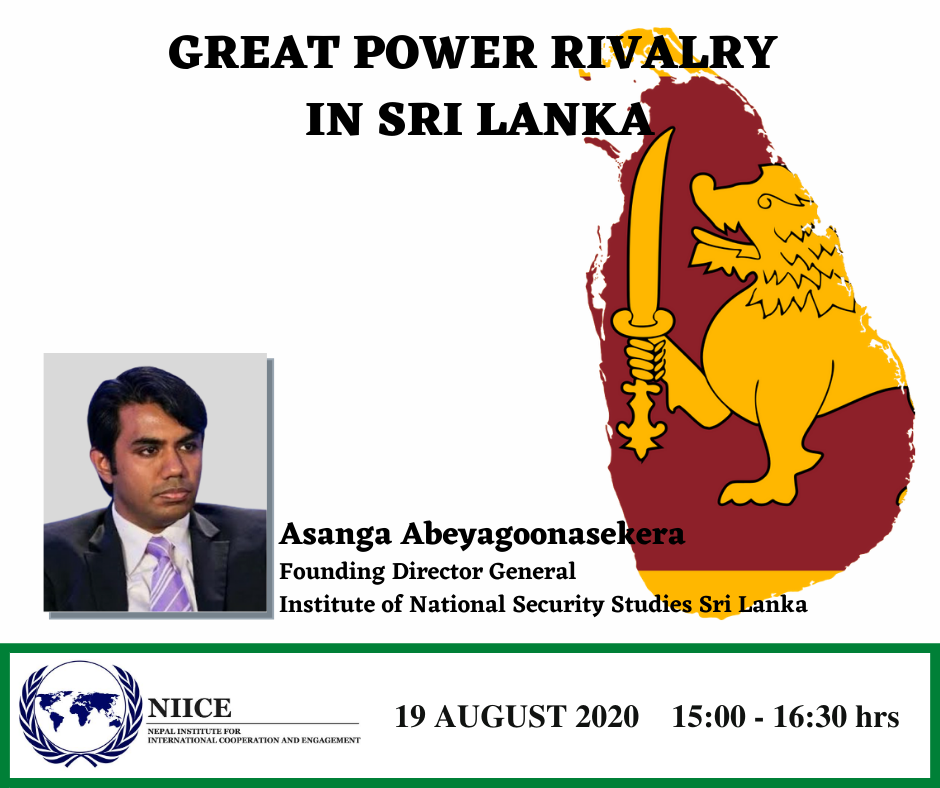
Great Power Rivalry in Sri Lanka – Asanga Abeyagoonasekara
Watch it on NIICE Nepal YouTube Channel
Event Report
NIICE Nepal organized a webinar on Great Power Rivalry in Sri Lanka. In this webinar, Asanga Abeyagoonasekera, the founding director general of Institute of National Security Studies Sri Lanka, discussed the great power rivalry in Sri Lanka. He begins the presentation by outlining the following issues: Sri Lanka's Geography, Two Theories and the Triple Sphere of Influence, Great power rivalry US-China/China-India, Chinese/US/Indian Sphere of influence in Sri Lanka, Sri Lankan Foreign Policy, Domestic Political Landscape, Challenges for Rajapaksa Regime. He described the Geo-strategic importance of Sri Lanka using several maps and looking at its history. He also explained the importance of Sri Lanka as a maritime hub because of its presence close to the oil supply route of China. He discussed how Sri Lanka is essential for other countries to get a strategic hold of the Pacific Ocean. He spoke about the relationship between China’s “Belt and Road Initiative” and Sri Lanka’s role and shed light on the US-China rivalry and its impact on Sri Lanka’s more extensive political and strategic interests. He spoke about the rivalry between the US and China and the role of globalization in this context.
Further, he explained two views by John J. Mearsheimer and Kishore Madhubani on China's rise. On the one hand, John J. Mearsheimer holds a zero-sum game perspective on China’s rise, while on the other hand, Kishore Madhubani holds a positive-sum peaceful perspective of China's rise. He stressed the importance of strategic alliances to contain China. He also discussed the massive Chinese investments in Sri Lanka's infrastructural projects and the government's outlook on mobilizing these Chinese resources.
According to the speaker, Sri Lanka follows a multi-aligned foreign policy more closely. He explained Sri Lanka's outlook in the region by quoting Mahinda Rajapaksa's remarks on Sri Lankan foreign policy and further mentioned the capacity of China's infrastructural diplomacy. He mentioned India's neighborhood first policy and India's SAGAR initiative and its relevance to Sri Lankan foreign policy. He spoke about the Sino-Indian rivalry and its impact on Sri Lanka and elaborated on how the Indian sphere of influence directly impacts Sri Lanka's domestic politics; in doing so, he particularly mentioned the role of Tamil Nadu and the Kaveri sphere of influence. He explained how Indian apprehension of the Chinese threat growing in Sri Lanka. This is expressed by the letter from T.R. Baalu, a Lok Sabha member, to Prime Minister Narendra Modi to request a revival of the 'Sethusamudram' Project to counter the Chinese threat on the southern shores of India. He concludes this part by mentioning how to balance the Triple Sphere and Triple Security Challenges. According to him, the Triple Security threats are Growing Extremist Terrorism, Eelam ideology - No solution from devolution, External Geopolitical Fissures to Sri Lankan Foreign Policy.
The webinar concluded with the speaker mentioning the four challenges to the Rajapaksa Regime, which are as follows: Preserving Democracy: He explained the importance of the upcoming Constitutional Reform - 20th Amendment. He also highlighted the need for separation of powers. Economic Condition: He talked about the careful handling of the economy in the upcoming Global recession. UNHRC and Reconciliation: He mentioned the challenges from the UNHRC and the possible ways to handle them. Equidistant 'balanced' foreign policy: Finally, he stressed the need for a balanced foreign policy. In the Q&A; round, he addressed how SLPP's win will affect India-Sri Lanka relations, the future Sri Lankan foreign policy, and possible response from India to combat China's 'String of Pearls' strategy, how Sri Lanka can develop economically and improve as a nation in the new era of great power rivalry. He explained how Sri Lanka could balance the 'Indo-Pacific strategy' of the United States and China's 'Belt and Road Initiative. He also explained the reality of Sri Lanka coming under China's 'Debt trap.' He further explained the dichotomous stance of India on infrastructural projects in Sri Lanka with the help of Chinese investment.
Prepared by Adrija Maity, Intern at NIICE, Nepal

Recent Comments